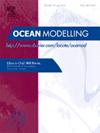Oblique interactions of mode-1 and mode-2 internal solitary waves in the presence of variable topography
IF 2.9
3区 地球科学
Q2 METEOROLOGY & ATMOSPHERIC SCIENCES
引用次数: 0
Abstract
Oblique interactions between internal solitary waves (ISWs) are frequently observed in oceanic environments. However, interactions involving different vertical modes, particularly between the most common mode-1 and mode-2 ISWs, remain poorly understood. To address this gap in knowledge, this study investigates the oblique interactions between mode-1 and mode-2 ISWs using a three-dimensional, high-resolution MITgcm ocean model. We consider three scenarios involving initial idealized V-shaped ISWs in a continuously stratified environment. The results show that interactions between two mode-1 ISWs over flat bottom topography align well with theoretical predictions. In contrast, interactions between two mode-2 ISWs demonstrate stronger attenuation due to potential instabilities arising from their complex vertical structures. When examining interactions between one mode-1 ISW and one mode-2 ISW, the differing phase speeds prevent the formation of Mach stems, resulting in non-resonant, refraction-like patterns. However, in the presence of a submarine cliff, where the phase speeds of these two modes become comparable, the interactions showed Mach stem-like features, along with energy transfer from mode-1 to mode-2 ISWs. Additionally, the presence of shoaling topography can lead to the emergence of mode-3 ISWs and polarity reversals.
可变地形下1型和2型内孤立波的斜向相互作用
在海洋环境中,内孤立波之间的斜向相互作用是经常观察到的。然而,涉及不同垂直模式的相互作用,特别是最常见的模式1和模式2 isw之间的相互作用,仍然知之甚少。为了解决这一知识空白,本研究使用三维高分辨率MITgcm海洋模型研究了1型和2型isw之间的倾斜相互作用。我们考虑了在连续分层环境中涉及初始理想v形isw的三种情况。结果表明,在平坦的海底地形上,两个1型ISWs之间的相互作用与理论预测一致。相比之下,两个模态isw之间的相互作用由于其复杂的垂直结构引起的潜在不稳定性而表现出更强的衰减。当检查一个模式1 ISW和一个模式2 ISW之间的相互作用时,不同的相速度阻止了马赫系统的形成,导致非共振,类似折射的模式。然而,在存在海底悬崖的情况下,这两种模式的相速度变得相当,相互作用表现出类似马赫干的特征,以及从模式1到模式2 isw的能量传递。此外,浅滩地形的存在可能导致3型ISWs的出现和极性反转。
本文章由计算机程序翻译,如有差异,请以英文原文为准。
求助全文
约1分钟内获得全文
求助全文
来源期刊

Ocean Modelling
地学-海洋学
CiteScore
5.50
自引率
9.40%
发文量
86
审稿时长
19.6 weeks
期刊介绍:
The main objective of Ocean Modelling is to provide rapid communication between those interested in ocean modelling, whether through direct observation, or through analytical, numerical or laboratory models, and including interactions between physical and biogeochemical or biological phenomena. Because of the intimate links between ocean and atmosphere, involvement of scientists interested in influences of either medium on the other is welcome. The journal has a wide scope and includes ocean-atmosphere interaction in various forms as well as pure ocean results. In addition to primary peer-reviewed papers, the journal provides review papers, preliminary communications, and discussions.
 求助内容:
求助内容: 应助结果提醒方式:
应助结果提醒方式:


